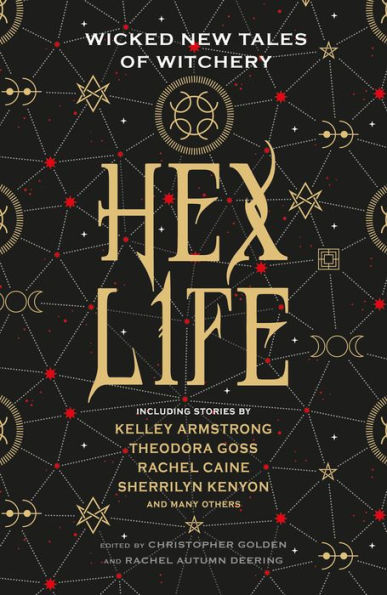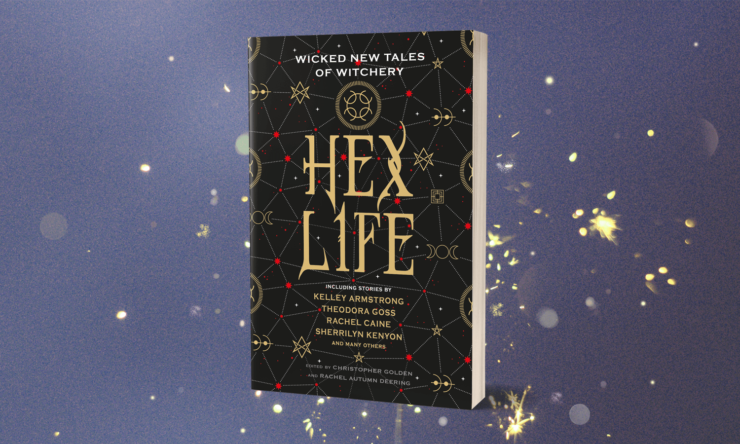Hex Life is a collection of 18 “wicked new tales of witchery”, edited by Christopher Golden and Rachel Autumn Deering. The witchery—an excellent word!—within takes many forms. There are fairy tales—gothic, contemporary, traditional and revisionist; haunting parables; dark comedies; scary stories, and even a few urban fantasies.
The range is fitting, as the concept of the witch is a diverse and long-lived archetype, and one that lends itself to many angles of exploration. Hex Life is particularly interesting when set against the backdrop of modern witchcraft, and its increasingly mainstream cultural presence. Contemporary witchcraft, at least in this popularised form, is “a combination of the aesthetic and the search for something spiritual”, according to Elisabeth Krohn, founder of Sabat. In a chaotic era, where so many people are searching for meaning, self-empowerment, or simply faith, the traditions and practices of witchcraft have stepped in to fill that void for many.
With few exceptions, the stories in Hex Life see witchcraft as a type of power—connection between like-souled individuals, women (as a collective), and often the greater natural world. Kat Howard’s opening story, “An Invitation to a Burning”, sets the stage well. Sage is a young woman in the ambiguously-located and vaguely-contemporary town of Merrinvale. She’s an outsider and, naturally suspicious—especially to men. She receives an invitation, is inaugurated into witchcraft, and finds a satisfying place in her world.
“Invitation” is short on plot, but long on thematic resonance, elegantly serving as the anthology’s de facto introduction. When Sage first enters the realm of mysteries, she encounters “the women [Sage] had seen her whole life, those she had waved to and passed by and traded bowls of soup and baskets of cookies with”. But here, they are no longer ordinary (or suspect); they, like Sage, have found where they belong. Howard shows that witchcraft provides power through belonging: a community for individual outsiders and the ultimate ‘safe space’ for women, to acknowledge and revel in their identity.
Witchcraft is also, according to Hex Life, essential. Howard, again, expresses it beautifully: “Merrinvale was a place that needed witches. Most places are, even if the people who live in them don’t realize it.” Witchcraft provides more than emotional fulfilment for unique individuals: it is an essential natural and social force. Witchcraft keeps society in balance, it serves a supernatural karmic enforcer.
For the most part, Hex Life presents the power of witchcraft as a positive force—magic solving the unsolvable problems. In Theodora Goss’s ambitious sequel to Snow White, “How to Become a Witch-Queen”, magic is the means by which political power becomes—if not democratised—at least more evenly distributed. Hillary Monahan’s “Bless Your Heart” takes place on a smaller scale, with a witch’s magical powers bringing justice (and gooey horror) to a PTO meeting. “The Deer Wife”, “The Memories of Trees”, “Gold Among the Black”, and the particularly excellent “Widows’ Walk”—all reinforce this theme. These stories have witchcraft stepping in when society fails; delivering the righteous resolution that mortal systems can or will not.
Amber Benson’s “This Skin” is the exception that proves the rule. It is, first and foremost, the only story in which the magic does not answer the call. And, in fact, lacks any supernatural element at all. A young woman initially seeks recourse through witchcraft, but instead finds her resolution through more mundane means. Theoretically, this is the most empowering story of all: the one tale in which a young woman does not need a fantastical, supernatural force to achieve her goals. Benson, however, takes this to a more disturbing place. It is delightfully chilling.
Buy the Book


Hex Life: Wicked New Tales of Witchery
This sense of witchcraft as the provider of balance—as natural force for justice—is even on display in the darker stories. In Kristin Dearborn’s “The Dancer”, a young woman’s powers shed light on long-dark secrets, and punish the wicked in a suitably macabre manner. In Ania Ahlborn’s “The Debt”, the titular price is unavoidable—however grim, a promise is a promise. Sarah Langan’s “The Night Nurse”, features a young mother making increasingly Faustian bargains with a surprisingly sinister childcare provider. “The Night Nurse” is easily one of the anthology’s best, not only for the evocative language, but because of the empathy it builds with exhausted, struggling Esme. Even as her choices become more extreme, there’s always a clear justification—if not necessity—underpinning them. And witchcraft, as always, is the engine that not only makes the impossible possible, but also demands the appropriate payment.
It is worth noting that the anthology also includes three stories that tie into existing worlds—by Rachel Caine, Kelley Armstrong, and Sherrilyn and Madaug Kenyon. All three managed to walk the fine line between providing the necessary background exposition and being self-contained stories in their own right. But that left little room for much else. Although these are packed with action—and undoubtedly rewarding for existing fans of the authors’ worlds—these were also the three stories that least explored the greater themes of witchcraft.
The witchcraft within Hex Life mirrors the greater search taking place throughout society: for belonging, for empowerment, and for a sense of justice. The need for faith: something we can all believe in. It is undeniably rewarding to read these stories, and revel in gory justice being meted out to the bullies and bad guys of the world. But Hex Life also comes with a forlorn underpinning. Back in the unpleasantly prosaic real world, the trees aren’t going to answer our call, we don’t have latent telekinetic powers, and supernatural forces aren’t going to sweep in and sort everything out. To paraphrase Shel Silverstein, all the magic we’ll ever know, we’ll have to make ourselves.
Still, if we lack grimoires full of magical solutions, at least we have anthologies full of very pleasant distractions. Hex Life is alternatively filled with gore and glory, and is a suitably mixed cauldron of styles and tones, but is vastly entertaining from start to finish.
Hex Life is available from Titan Books.
Read an excerpt from Jennifer McMahon’s “The Deer Wife” here.
Jared Shurin is the editor of The Djinn Falls in Love, The Outcast Hours, The Best of British Fantasy, and many other published and/or forthcoming works. He writes irregularly at raptorvelocity.com and continuously at @straycarnivore.










